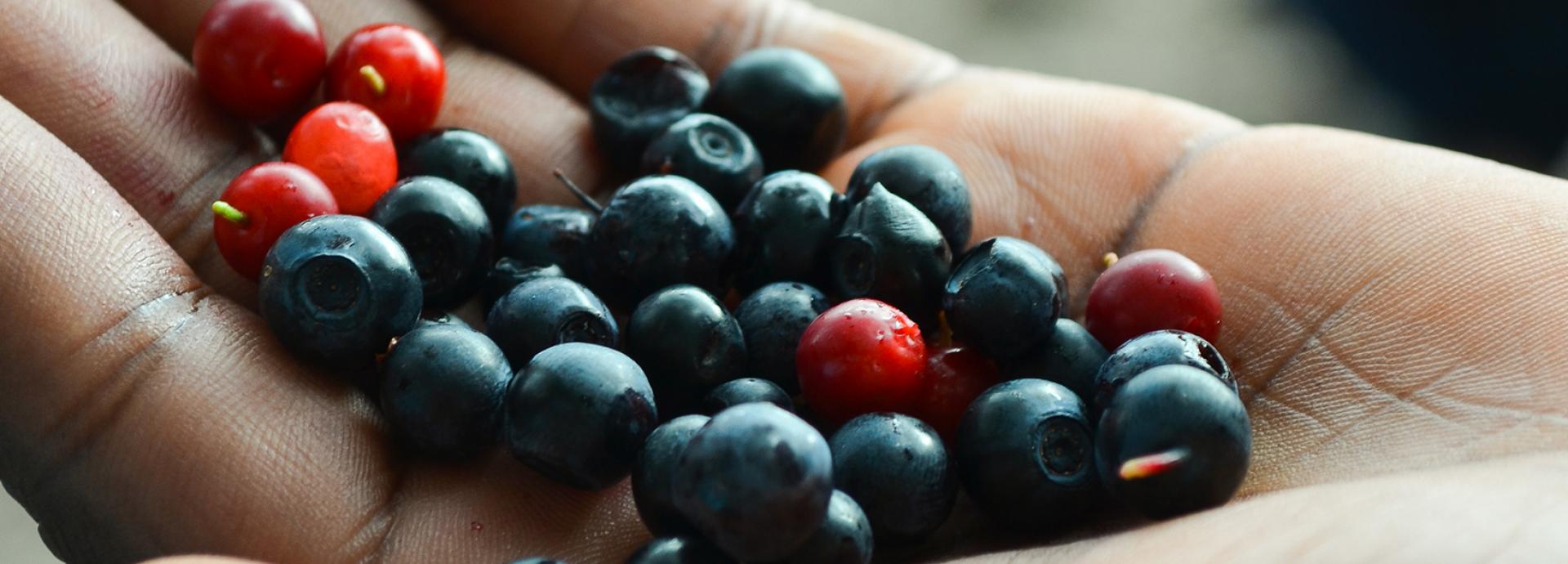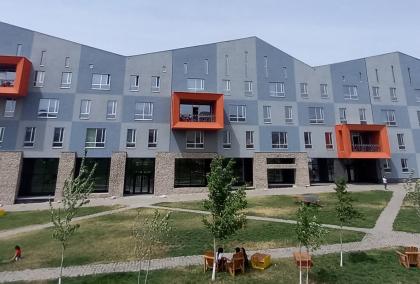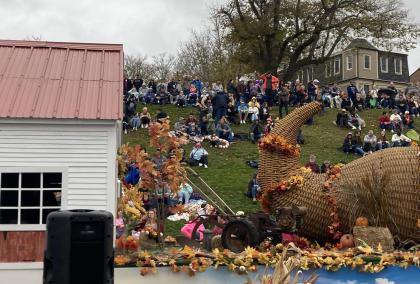

It would be useful to bring your favorite cookbook, both for direct use and as a reference for questions about American food that you may be asked. Get a recent copy that has metric and American measurements. You may also wish to bring measuring utensils with both gradations.
Finnish Food
Finnish cuisine has western European, Scandinavian and Russian elements. Table manners are European. Breakfast can be quite substantial. Lunch is usually eaten between 11 am and 2 pm, a typical lunch break at work lasting less than an hour. Evening meals at home are eaten around 5–6 pm.
Price of Food
Typical American foodstuffs are generally available in Finland, although imported foods from outside the European Union countries may be more expensive than those produced domestically. Prices vary according to seasonal and market fluctuations. You will find grocery stores to be high quality, clean and professional in their training and service.
For budgeting purposes, you should estimate high and project food costs as roughly double those in the United States, until you become familiar with the local cuisine and are able to read the advertised specials in the local markets. If you limit your shopping to what you normally eat back home or what looks familiar, you may have high food costs. Learn to shop around. The same product will vary in price from one store to the other.
Generally, meat is more expensive than in the United States. However, fresh fish is plentiful and often inexpensive. Salmon and rainbow trout are good, often on special, and less expensive than beef or chicken.
There is a great variety of high-quality breads and dairy products. Almost all wintertime fresh fruits in Finland are imported, but specials on apples, oranges, and bananas may have prices comparable to those in northern regions of the United States.
Remember to weigh your fruits and veggies and print a price label while in the produce section to avoid delays at the checkout counter.
The key to maximum purchasing power is to learn Finnish food and shopping terminology, and then take advantage of frequent specials, gradually modifying your diet as seasonal changes present new values.
The Google Translate App is really useful for reading labels at the grocery store. -U.S. Student Grantee 2013-2014
If you are vegetarian/vegan/lactose-intolerant/gluten-free, don't worry! You have a lot of options to choose from. I would daresay, better than U.S. - U.S. Student Grantee 2014-2015
Fresh vegetables vary in price from moderate to expensive, but are available throughout the year. Frozen vegetables are also available. Frozen berries and canned fruit, meat, vegetables and soups tend to be expensive. Bakery goods are readily available, abundant, and delicious.
Grocery Chains
K-market, S-market, Alepa, Citymarket and Prisma are common grocery chains in Finland. Many department stores may also have a grocery store, often located at the ground floor. The cheap German chain Lidl, is also a popular choice for daily grocery items.
American Brands
Grantee children will notice that some American staples - such as Jello and chocolate chips - may not be easily available. Nowadays you can find peanut butter, M&Ms, and marshmallows in most shops. While children soon become accustomed to new food choices, it is sometimes useful to cache a supply of familiar junk food for culture-shock emergencies. A plastic bucket of "exotic" items can be mailed ahead and may be useful one dark November night.
Behnford’s in Helsinki city center carries a limited selection of American staples such as Jiff, Betty Crocker, and Reese’s Peanut Butter Cups. Also some supermarkets stock American food staples.
Eating Out
In most restaurants, dinners are served from 6 pm onwards. Many restaurants stop serving food about 45 minutes before they actually close, so it is worthwhile checking the serving times when booking a table. Concerts and theater performances usually begin at 7 pm, and some in the audience will adjourn to restaurants at around 10 pm.
Restaurant menus and home cooking rarely involve food that western visitors would not be acquainted with. Ethnic restaurants, constantly increasing in number, have added to the expanding choice. Beer and wine are drunk with restaurant food in the evening, but at lunchtime these days they feature very little, if at all.
At a formal dinner party, the host determines the seating order if necessary. Guests should not begin to eat until everyone has been served; usually, the host will propose a toast at the beginning of the meal, wishing his guests “hyvää ruokahalua,” the Finnish for bon appétit! It is not appropriate for guests to drink before this, unless the beginning of the meal is badly delayed.
Finns seldom make speeches during a meal, but they do so on formal occasions. In such cases, the speeches are made between courses. During the meal, the host may toast individual guests, or guests may toast each other, by raising their glasses and making eye contact. Once the toast is drunk, eye contact should be made again when lowering the glass to the table.
A meal normally concludes with coffee and postprandial drinks are served with it or immediately after. When leaving the table, the guests should thank the hosts briefly for the fare when they get the chance, regardless of whether the guest of honor has done so or not. And remember that it is good manners to bring a small gift of flowers or chocolates to the hostess when visiting a home.
University restaurants
Both students and staff have access to subsidized daily meals at university restaurants and cafeterias. While not necessarily gourmet delights, these well-balanced and filling meals could lower your food costs considerably. Student lunch in a university restaurant costs around 2-3 euros, as a lunch in a regular restaurant costs around 10 euros.
Cigarettes and smoking
Cigarettes and alcohol are heavily taxed in Finland and are consequently quite expensive. Cigarettes are more than six dollars a pack, and smoking is restricted in public buildings and transportation.
Smoking is prohibited in public buildings and workplaces and, being generally law-abiding, Finns have adapted to this legislation and only smoke in specially designated areas. The number of smokers is continuously declining, nevertheless, smoking is still common in all age groups.
Smokers are expected to be considerate. When invited to a private home, a guest should only smoke if the host smokes. In a private home, smokers may be guided to the balcony.
Alcoholic beverages
Light alcohol (up to 5,5 %) is sold in grocery stores, anything stronger is only available in state-run ALKO liquor stores. The ALKO stores are normally open from 9 or 10 am to 9 pm on weekdays and 6 pm on Saturdays. They are closed on Sundays and public holidays. The minimum age for the purchase of beer and wine is 18, and for stronger drinks 20. Alcoholic beverages in bars and restaurants are relatively expensive. Nevertheless, Finns have acquired a reputation for high alcohol consumption, and some of the local drinking habits may raise eyebrows.
Consumption of wine and beer, as opposed to spirits, has increased in recent years, and as a result more decorous drinking behavior has become more common.
Consumption of alcohol at lunchtime is less common in the business world than it used to be, and in the public sector it is extremely rare. Alcohol consumption varies somewhat, according to socio-economic differences and, to some extent, by region. The influence of central European or Mediterranean drinking habits is primarily visible among urban middle class young adults and slightly older Finns with higher education.
Visitors can approach Finnish drinking customs as they see fit. It is not necessary to drink a shot of schnapps in one gulp even if your neighbor does. It is also perfectly acceptable to request mineral water with a meal.
Lunch is accompanied by non-alcoholic beverages in any case, and non-alcoholic drinks are usually provided. Abstinence is also supported by legislation; in Finland, the blood alcohol level for drunken driving is very low, and the penalties are severe.
“I have found that the most interesting and educational aspects of this exchange have taken place in local pubs, where I have had a chance to meet many Finns outside of the University setting. I think such encounters can be particularly stimulating in Finland, because many working class people here are quite well-educated, and have a strong command of the English language, and in contrast to the United States, are easy to get to know over beers. Indeed, I would suggest that for younger scholars (students and professors alike), you might provide formal information about the rules of social behavior that would help make Fulbrighters feel less afraid of going out to pubs and meeting Finns in one of their more interesting (and more “open”) settings. Perhaps it wasn’t exactly what Senator Fulbright had in mind when he was thinking about cross-cultural exchange, but in this way, I’ve learned a great deal about Finnish culture, class relations, popular political discourse (local thoughts about EU membership, for instance), and real life in Finland.”
“Anything you can do to make Americans less afraid to make this step into public life in Finland (especially when they know NO Finnish, and carry with them stereotypes from the U.S. that establishments like pubs are “closed” and dangerous places for outsiders to the community) will only add to cross-cultural understanding. Some places DO fit this stereotype, especially if the foreigner does not know how to act, but a few simple guidelines could open up a lot of great terrain for people willing to take the leap—especially because Finns really do open up in pubs. I suspect I am in the minority as far as professors go (unless like me they are of an “anthropological” bent), but I think this could be quite useful for students who are still of an age that would find the night life“
Coffee and tea
Consumption of coffee per capita is higher than anywhere else in the world. The traditional Finnish coffee brew may seem weaker than American blends, however, many coffee brands and beans are available if you want something stronger.
Tea has become very common too and you will be given an option to choose between coffee and tea when visiting people.
Be open to new adventures, and always say yes to coffee, korvapuusti, karjalanpiirakka with egg butter, and reindeer! -U.S. Student Grantee 2013-2014
Tipping
Tipping in Finland is uncommon but not unheard of. It is totally OK to leave a tip, but no one will expect you to pay one. In bars the staff will appreciate if you leave a few coins in the tipping jar.
If you are the guest of Finnish hosts, you should leave any tipping to their discretion.


